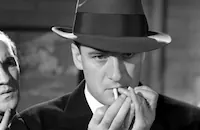The Saint's Double Trouble

Brief Synopsis
Cast & Crew
Jack Hively
George Sanders
Helene Whitney
Jonathan Hale
Bela Lugosi
Donald Macbride
Film Details
Technical Specs

Synopsis
In Cairo, The Partner, a member of a gang of international jewel thieves led by Boss Duke Bates, ships a mummy to Professor Horatio Bitts in Philadelphia under the name Simon Templar. By coincidence, Inspector Henry Fernack of New York is visiting John Bohlen of the Philadelphia police department when Bohlen is called to Bitts' house to investigate a murder. Private detective Simon Templar, known as "The Saint," had been visiting the professor, an old friend, earlier that evening, and when Fernack finds a card belonging to the Saint on the murdered man's body, Bohlen concludes that Templar is the murderer. Later that night, Templar visits Fernack in his hotel room, where the inspector confides that he believes him to be innocent. After leaving Fernack, Templar returns to the scene of the murder, and meets the professor's daughter Anne and inspects the mummy. Unknown to Templar or the police, Boss Duke Bates is Templar's exact double and has been impersonating Templar. After Boss kills a jewelry fence, Templar traces the fence's murderer to the Boss's hideout at the 4 Bells Cafe and discovers that he has a double. Meanwhile, Boss learns that there is another package of gems concealed in the mummy's body and returns to Bitts's house, where he kills the professor. Templar, still evading the police, sends Anne and Fernack messages directing them to the 4 Bells Cafe. Boss intercepts Anne, however, and orders her elimination, but Templar saves her life at the last moment. Templar then returns to Boss's headquarters, where he is captured and thrown, tied and gagged, onto a boat. As Boss plans Templar's demise, Fernack and the police arrive. Believing that Boss is the Saint, the police arrest him, and after they leave, Templar escapes from the boat. To regain the jewels and prove his innocence, Templar, disguised as a woman, visits Boss in his cell and allows Boss to overpower him, don his disguise and escape. When Boss is shot down by a police officer, the Saint's "double trouble" comes to an end, and Fernack allows Templar to escape after he returns the jewels.

Director
Jack Hively
Cast

George Sanders
Helene Whitney

Jonathan Hale

Bela Lugosi

Donald Macbride
John F. Hamilton
Thomas W. Ross

Elliott Sullivan
Crew
Leslie Charteris
Doran Cox
Albert D'agostino
Ben Holmes
J. Roy Hunt
Lee Marcus
Desmond Marquette
Hugh Mcdowell Jr.
Van Nest Polglase
Cliff Reid
Renie
Vernon Walker
Theron Warth
Roy Webb
Roy Webb

Film Details
Technical Specs

Articles
The Saint's Double Trouble
The Saint's Double Trouble (1940), despite some erroneous references to the contrary, was not based on a Charteris book, although some sources claim the author contributed to developing the basic story. The fourth film in the series begun by RKO in 1938, it was the first not taken from a novel and the third to star George Sanders. Reportedly Charteris didn't like the movie very much, but that might be partially due to his belief that Sandersand the first film Saint, Louis Haywardwere "hopelessly miscast." He would have preferred Douglas Fairbanks Jr., Ronald Colman, or Cary Grant. Nevertheless, Sanders was the most famous portrayer (until Roger Moore brought the character back for British TV), playing the part for two more of the remaining five installments of the series. Hugh Sinclair took over for a further two pictures, and Louis Hayward came back for the final one, aptly named The Saint's Return (1953). Jean Marais played Templar in a 1966 French version, several actors took the part on various TV series based on the stories, and American Val Kilmer played the part on the big screen in a 1997 version that altered much of Charteris's original conception.
The Saint's Double Trouble plays on the notion that Templar was once a criminal, a background that allowed him a certain edge in solving crimes by means usually off limits to law enforcement. Here, Sanders gets to be both good and bad guy, playing a double role as Templar and a doppelgänger crime boss. The device allows Sanders to perform a scene as Templar pretending to be the crime boss confronting the crime boss pretending to be Templar. It also allowed for some amusing quips by reviewers, such as New York Times critic Frank Nugent's claim to have overheard a boy in the movie theater remark, "Ain't he the spittin' image of himself, though."
Screen Dracula Bela Lugosi made one of his occasional attempts to break free of his horror movie typecasting with a role as the crime boss's partner in this picture. The effort was fruitless; Lugosi's next assignment was a small part in Black Friday (1940), a mad scientist story starring Boris Karloff.
The screenplay was written by Ben Holmes, a writer and director of mostly B pictures from the late silent period until his early death in 1943. Holmes previously directed the first movie to feature Simon Templar, The Saint in New York (1938). The Saint's Double Trouble was shot on RKO's back lot in just 19 days by director Jack Hively, who started his film career as an editor. His last credited work in that field was on The Saint Strikes Back (1939). He directed two more in the series after this: The Saint Takes Over (1940) and The Saint in Palm Springs (1941).
Director: Jack Hively
Producer: Cliff Reid
Screenplay: Ben Holmes, based on a character created by Leslie Charteris
Cinematography: J. Roy Hunt
Editing: Theron Warth
Art Direction: Van Nest Polglase
Original Music: Roy Webb (uncredited)
Cast: George Sanders (Simon Templar/The Boss), Helene Whitney (Anne Bitts), Jonathan Hale (Inspector Henry Fernack), Bela Lugosi (The Partner).
BW-67m. Closed Captioning.
by Rob Nixon

The Saint's Double Trouble
Quotes
Trivia
Notes
For additional information about "The Saint" series, consult the Series Index and see entry above for The Saint in New York.














